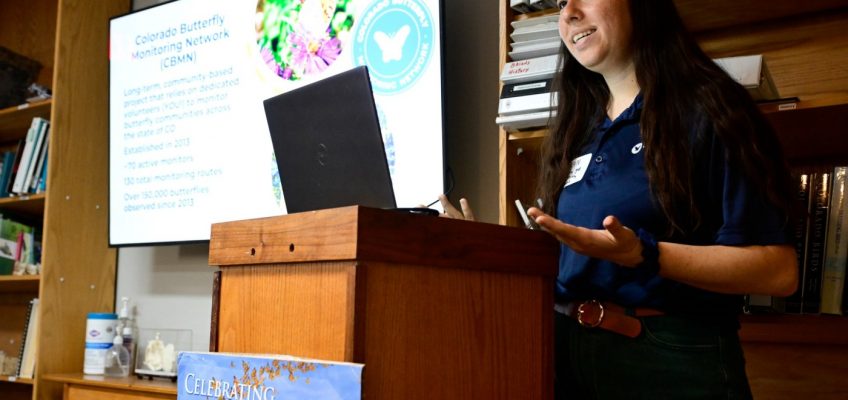A butterfly flits past the window at the Castlewood Canyon Visitor Center, where dozens of volunteers have gathered to learn about Colorado’s declining butterfly population and how they can do their part to save it.
Shiran Hershcovich, a lepidopterist at the Westminster-based Butterfly Pavilion who’s leading the Saturday morning training, ushers the group outside to watch the mourning cloak butterfly as it settles on a blooming tree.
It lightly beats its wings until someone shuffles too close, startling it back into the sky.
Now, more than ever, scientists are calling for volunteers to help gather data on butterflies so organizations know where to focus resources to save the rapidly disappearing insects, Hershcovich said. Some volunteers undergo official training, but anyone can contribute just by posting photos online.
North American butterfly populations have declined by more than 22% over the last two decades, according to a study recently published in Science. Colorado saw roughly the same levels of loss, Hershcovich said.
The national study combined 20 years of data from 35 community science programs across the country, including the Butterfly Pavilion’s Colorado Butterfly Monitoring Network.
An average loss of 1% each year might not sound like a lot, but it dramatically affects butterfly populations, Hershcovich said.
“The results were pretty grim,” she said. “We’re really at a critical point where we can either work hard to turn those numbers around or lose our butterflies.”
Folks listen in on a Colorado Butterfly Monitoring Network training at the Castlewood Canyon State Park in Franktown on Saturday, May 3, 2025. (Photo by Andy Cross/The Denver Post)
People-powered science
The first step is knowing where to direct resources and action, Hershcovich said. That’s where volunteers come in.
Cindy Cain, a nurse practitioner at the University of Colorado, was hiking in Jefferson County’s Reynolds Park five years ago when she saw a woman with a clipboard looking around. One conversation, one year and one training later, Cain had her own clipboard and was officially part of the Colorado Butterfly Monitoring Network.
She said she started with one trail but “just kept on accumulating routes.” She now monitors more than a dozen different routes for the network throughout the season.
“I know that it’s not everyone’s jam, but it makes my heart sing,” Cain said.
The monitoring network started with five volunteers in 2013. It reached nearly 100 volunteers across 12 Colorado counties in 2024 and it trained another 71 in 2025.
As of October 2024, the end of that year’s monitoring season, the network of Colorado volunteers had spent nearly 4,900 hours on trails across the state and documented more than 144,000 butterflies since its 2013 kickoff.
Change happens when everyone becomes involved in the conversation, Hershcovich said. It’s not limited to entomologists and other scientists — everyone has a stake in the game and the power to help.
“There’s a growing sense of ‘What can I do? How can I make a change?’, which is really empowering,” Hershcovich said. “(Volunteers) help us gather data and inform those collective pictures of what’s going on with the butterflies.”
Butterflies at risk — both in Colorado and nationally
The mountain-prairie region that encompasses Colorado is seeing the second-most severe annual butterfly declines and some of the most rapidly warming climate, according to the national study in Science.
“Places like Colorado are already dry,” said Ryan St Laurent, an evolutionary biologist and entomologist at the University of Colorado Boulder. “With increased droughts that we’re seeing with climate change, it’s exacerbating the existing problems that we’re already having with butterfly decline.”
The impacts of widespread butterfly loss and other invertebrate insects are almost unthinkable, St Laurent said.
“They pollinate plants, and they basically fill every ecological role you can imagine in terrestrial environments,” St Laurent said. “When you’re seeing declines, even if it’s a percentage here, a percentage there, … we are going to be feeling the impact of that in ways that we probably don’t even realize yet.”
The extent of the loss varies across both butterfly species and regions, but the overall theme is the same: butterflies are in danger, Hershcovich said.
“It’s a complex picture of ups and downs, but what we do know for certain is that, overall, we are losing more butterflies than we are gaining,” she said. “It’s a pretty scary picture.”
Colorado’s diverse wildlife habitats are home to more than 250 types of butterflies, roughly a third of the species found in North America.
The Colorado Butterfly Monitoring Network has captured data on 173 of those, Hershcovich said.
Most of Colorado’s butterfly monitors are concentrated in the Front Range, so the network’s data on butterflies native to Colorado’s Eastern Plains or high mountains is sparse, she said.
But the network will never turn away a volunteer, no matter where they’re based, Hershcovich said. More eyes are always needed, including across the Front Range.
“We need to know what’s going on with butterflies everywhere, not just in the high mountains, but … in our neighborhoods and in our backyards and in our gardens and in our community spaces,” Hershcovich said.
The other barrier to fully understanding Colorado’s butterfly populations is the difficulty of accurately surveying the pollinators, said Gillian Bowser, a wildlife biologist and ecologist with Colorado State University.
“Data is dependent on what people perceive and record,” Bowser said. “We see monarchs and we value monarchs, but we often fail to perceive blue butterflies because they’re so small. … We have huge data gaps.”
Butterflies are active for very short, dynamic periods, she said. If scientists aren’t consistently surveying butterfly populations from early spring to late fall, they miss the entire lifespans of multiple species.
Butterflies are on display during a special preview of The Butterfly Conservatory: Tropical Butterflies Alive in Winter at the American Museum of Natural History in New York October 4, 2017. – The Butterfly Conservatory houses up to 500 iridescent butterflies that hover above visitors in a 1,200-square-foot vivarium. (Photo by TIMOTHY A. CLARY / AFP) (Photo credit should read TIMOTHY A. CLARY/AFP via Getty Images)
The combination of staffing, timing and difficulty spotting certain butterflies means scientists have solid trend data on less than half of known butterfly populations, Bowser said.
“There’s just not enough people out there collecting data,” St Laurent said.
But data collection isn’t just limited to scientists or formally trained volunteers — it’s as easy as snapping a photo and posting it on social media or a community science platform like iNaturalist, Bowser said.
Scientists use photos from social media and other platforms to track butterfly populations across the state, see how early or late they’re appearing in the season, determine if they’re shifting habitats and more, Bowser said.
“Engaging nonexpert participants in butterfly data is probably more critical than almost anything else,” she said. “Everybody’s got a cellphone and everybody has access to the internet. You can take a picture and post it somewhere, and that’s … really good data.”
Monarch butterflies are seen in the trees as they overwinter in and around the Pacific Grove Monarch Sanctuary in Pacific Grove, California on January 26, 2023. – As devastating storms pounded California, nature lovers feared for fragile, endangered monarch butterflies that winter here as part of a seemingly magical migration pattern.
The colorfully winged insects that travel vast distances over the course of generations have been closely watched here since they neared extinction just three years ago.
As soon as the sun rose one January morning, volunteers began counting monarch butterflies, finding them clustered atop cypress trees in a sanctuary in the California coast town of Pacific Grove. (Photo by Amy Osborne / AFP) (Photo by AMY OSBORNE/AFP via Getty Images)
The public needs to be engaged, Bowser said. There are so many species to track that it takes the entire community’s help.
Researchers ID organisms behind toxic algae bloom
The National Weather Service issues Alaska’s first ever heat advisory
Peanuts or almonds? Rice or millet? Planet-friendly grocery shopping choices go beyond cutting meat
Ping, ping ping. Here’s what it’s like to drive into a big hailstorm in the name of science
As labor costs rise, AI is learning to farm
“Glimmers of hope”
It’s still possible for butterflies to completely recover and flourish, St Laurent said, noting that even the national butterfly decline study provided some “glimmers of hope” for the future.
“Insects are some of the most resilient animals on this planet and, should they have the right conditions, they can once more thrive,” Hershcovich said. “It will require some work. It will require a lot of action. It really is an all-hands-on-deck moment.”
The good news is that scientists know what butterflies need and how to help, she said. The monitoring network helps scientists know where to focus their efforts and if they’re moving in the right direction.
It starts with planting native vegetation and pollinator gardens, reducing pesticide use and protecting open spaces.
“As soon as our natural spaces are degraded or damaged, butterflies are going to be one of the first things that respond to those changes,” Hershcovich said. “That’s why it’s so important to study them, track them, understand them and see how they fluctuate year after year, because they’re an important piece in getting a holistic picture of how Colorado is doing overall.”




